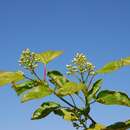en
names in breadcrumbs


Acer ginnala, the Amur maple, is a plant species with woody stems native to northeastern Asia from easternmost Mongolia east to Korea and Japan, and north to the Russian Far East in the Amur River valley. It is a small maple with deciduous leaves that is sometimes grown as a garden subject or boulevard tree.
Acer ginnala is a deciduous spreading shrub or small tree growing to 3–10 m (9.8–32.8 ft) tall, with a short trunk up to 20–40 cm (8–16 in) diameter and slender branches. The bark is thin, dull gray-brown, and smooth at first but becoming shallowly fissured on old plants. The leaves are opposite and simple, 4–10 cm (1+1⁄2–4 in) long and 3–6 cm (1+1⁄4–2+1⁄4 in) wide, deeply palmately lobed with three or five lobes, of which two small basal lobes (sometimes absent) and three larger apical lobes; the lobes are coarsely and irregularly toothed, and the upper leaf surface glossy. The leaves turn brilliant orange to red in autumn, and are on slender, often pink-tinged, petioles 3–5 cm (1+1⁄4–2 in) long. The flowers are yellow-green, 5–8 mm (0.20–0.31 in) diameter, produced in spreading panicles in spring as the leaves open. The fruit is a paired reddish samara, 8–10 mm (0.31–0.39 in) long with a 1.5–2 cm (5⁄8–3⁄4 in) wing, maturing in late summer to early autumn.[1]
Amur maple is closely related to Acer tataricum (Tatar maple), and some botanists treat it as a subspecies A. tataricum subsp. ginnala (Maxim.) Wesm.[2] The glossy, deeply lobed leaves of A. ginnala distinguish it from A. tataricum, which has matte, unlobed or only shallowly lobed leaves.[1]
Acer ginnala is grown as an ornamental plant in northern regions of Europe and North America. It is the most cold-tolerant maple, hardy to zone 2. It is naturalised in parts of North America. Planted on exceptional sites facing south west with consistent moisture and light loamy soils, this tree can grow 3 to 4 feet per year making it a fast grower. It is often planted as a shrub along borders.[3]
In the UK it has gained the Royal Horticultural Society's Award of Garden Merit.[4]
It is also valued in Japan and elsewhere as a species suitable for bonsai.
It is a nonnative invasive species in parts of northern America.[5]
Due to its vigor and fall colors of yellows and bright reds, the size being a small tree of 6 metres (20 feet) wide by 6 m tall on average, it suits many for smaller landscapes and for planting under power lines. Cultivars have emerged for those wanting these attributes.
Acer ginnala, the Amur maple, is a plant species with woody stems native to northeastern Asia from easternmost Mongolia east to Korea and Japan, and north to the Russian Far East in the Amur River valley. It is a small maple with deciduous leaves that is sometimes grown as a garden subject or boulevard tree.